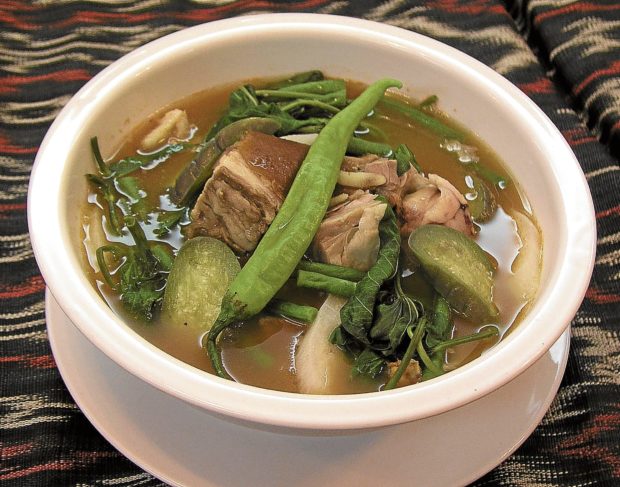One of the wittiest—but quite pointed—commentaries on the news that the Department of Trade and Industry (DTI) has formed a committee to come up with a “national standard” for recipes of popular Filipino dishes came from screenwriter, film director and home cook Marlon Rivera. Below are two of his Facebook posts that read almost like a script, reprinted with his permission.–Ed.
DTI : Sinigang is generally a clear soup.
Filipinos: Could be cloudy because of gabi or hugas bigas or bayabas etc.
DTI : Should have a souring ingredient.
Filipinos: Could be with sampaloc, kamatis, bayabas, kamias, murang siniguelas, dahon ng libas, batwan, Maggi, Knorr, unripe pomegranates from Ollioules, etc.
DTI: Should be with pork.
Filipinos : Could be with chicken, baka, baka na may taba, bangus, salmon, hipon.
DTI: Should be with vegetables.
Filipinos: Sa amin talong, sitaw, kangkong. Sa amin may dahon dapat ng sampaloc. Sa amin dapat may mustasa. We want radishes in ours. We like okra in our sinigang. Etc., etc., etc. Dapat may siling berde para pag higop may anghang sa dulo.
Filipinos: Dapat may sawsawan! Patis at sili. Bakit walang kalamansi?
Filipinos : Wait until you taste my mom’s sinigang. No, my Tita Charito makes the best sinigang. We should go to _______ for the best sinigang!
Or we can make the DTI sinigang! Sure.
* * *
I learned my way around the kitchen not with recipes but with basic “methods”—fry, boil, grill, kilaw, gata.
Fry fish, baka, manok, bulad, eggs. Boil vegetables, usually malunggay, and then build over that—add other vegetables, add corn, drop fresh tamban or fried fish or daing.
Grill anything fresh when the weather permits—complex marinades came much later.
Kilaw dilis (a pain to prep) with vinegar and aromatics. Kilaw tanigue when my father was around to do it.

Stir-fry followed fry. Boil and fry turned to monggo. Sauté and boil made halaan soup better. Boil plus souring ingredient became sinigang.
Kilaw advanced to scorched and minced goat skin.
Techniques were elaborated and became bases for experimentation.
Then I learned how to make pansit bihon through our neighbor: fry things, put lots of liquid then drop the noodles. And I sort of follow the same procedure with a few more noodle-based dishes: sauté things, add liquid, dump noodles in. Additional ingredients will get me to miki or canton.
Then came adobo. Ours started pale because we used salt instead of toyo. I have been elaborating on my adobo over the years so I have a few versions. I like all my versions basta my acid.
Then I graduated to the tomato sauce based dishes—afritada, mechado, menudo (my least favorite), caldereta (my favorite). I just have to remember certain non-negotiables per dish, but the rest is open to substitutions or a few additions.
Together with the early techniques is this attitude: cook what you’ve got on hand and just do it. The recipes came after I learned these building blocks, came after I can be trusted with precious ingredients, came after I was earning money so I can decide what to buy.
My attitude toward Filipino cooking is more like, lock in the essential character of a dish, and the rest is my own take.
Recently, my mother just added luya and white beans into our nilagang baka, and that recipe will be a keeper.
It’s when I try dishes from other regions that I ask friends and Google for recipes. And when I’ve learned the recipe, I adjust things according to my taste or resources. I never tell Kapampangans, Ilonggos and Caviteños how I’m reinterpreting their dishes in my own kitchen, in my own time. That’s asking for trouble. (Laughing emoji)
When non-Filipino friends are interested in certain Filipino dishes, I just give them the relevant methods and essential character of the dish and the rest is negotiable. Or, they can tell as many Filipinos as they know (even strangers) and wait to be offered the best version ever.

